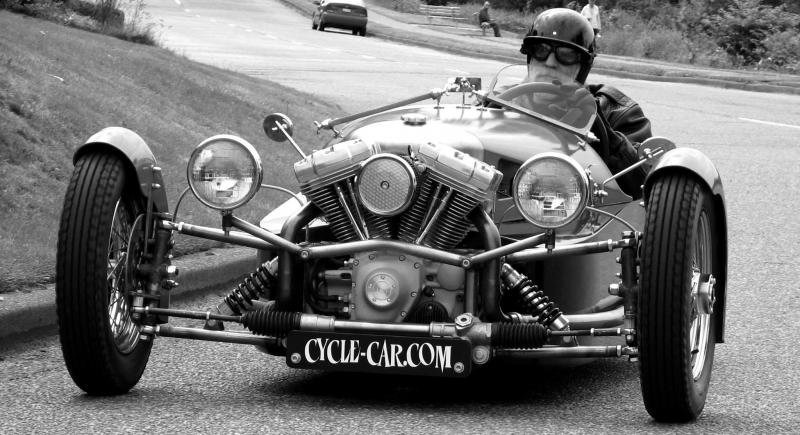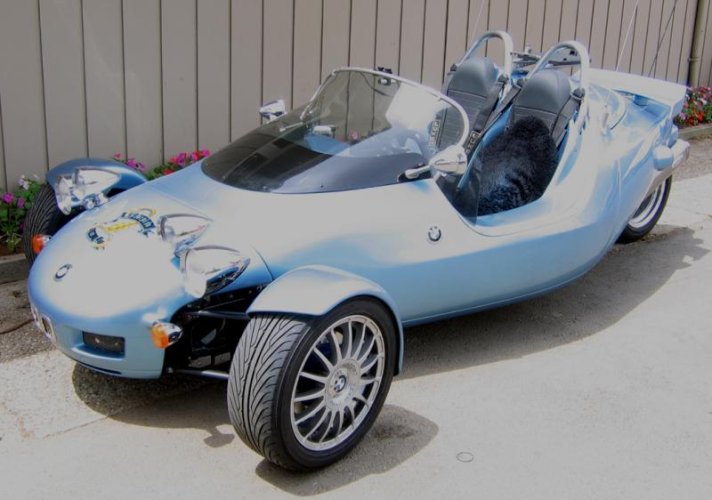I haven't driven the RT. Fred Rau is very enthusiastic about the RT. It has the same systems as the RS, but considerably more luggage capacity, larger windshield, etc.
Fred's wife Cherrie apparently likes the Spyder RT better than the Gold Wing, from the perspective of a passenger.
And certainly, Fred and Cherrie have put down a lot of miles on Spyders over the past couple of years. Fred has become a consultant to BRP on the development of the RT. BRP is a huge firm with lots of experience in personal watercraft, snowmobiles, and regional aircraft. They also own Rotax in Austria, and Johnson and Evinrude outboard motors in the USA. But with no experience in motorcycle touring, they really did listen to Fred and take his advice.
Last December I flew to LAX to borrow a Spyder demo. I had expected an RT, but the PR firm had lent theirs to Rider magazine, so I got an RS very similar to mine. During out trip to Las Vegas, Fred asked me whether I would have chosen the RT over the S if one had been available. Since my wife no longer rides on motorcycles, I decided I would have chosen the RS. However, I did add the BRP/GIVI bags, and carry a big adventure duffle on the back for additional gear.
In terms of handling, I followed Fred through some twisty backroads in the Mojave, and he didn't seem to be slowed down by the additional weight. I believe the RT has a slightly wider footprint.
On the flip-flop back to LA, I mulled over the implications of a trike vs a two wheeler. Obviously, a two-wheeler is much more agile in corners and requires much less effort. But there I was motoring west on the superslab. For someone who really enjoys cornering, a good handling bike is great. But the reality is that most of us spend more than 90% of our miles on relatively straight roads. And a trike shines in that environment.
Apparently, BRP has had complaints of handling with the RT, and they seem to take all the reports seriously. But they have also found that owners are often ignorant of maintenance issues that most motorcycliest understand. For instance, when they investigated one "bad handling" case, they found tire pressures at 8psi and shocks set on soft.
My advice: take both the RT and RS for a demo ride, as long as they will let you get away with. Be aware that an experienced motorcyclist will typically over-correct for minor tracking excursions, and that may cause you to think it's not steering correctly. You have to learn to relax and let it track more side-to-side than a typical two-wheeler--similar to driving a sidecar outfit. It takes about a week to get used to the feel and learn to trust it. I've also learned to watch road crown, and put the rear tire just to the left of the lane center "hump" to stabliize my line.
pmdave
Fred's wife Cherrie apparently likes the Spyder RT better than the Gold Wing, from the perspective of a passenger.
And certainly, Fred and Cherrie have put down a lot of miles on Spyders over the past couple of years. Fred has become a consultant to BRP on the development of the RT. BRP is a huge firm with lots of experience in personal watercraft, snowmobiles, and regional aircraft. They also own Rotax in Austria, and Johnson and Evinrude outboard motors in the USA. But with no experience in motorcycle touring, they really did listen to Fred and take his advice.
Last December I flew to LAX to borrow a Spyder demo. I had expected an RT, but the PR firm had lent theirs to Rider magazine, so I got an RS very similar to mine. During out trip to Las Vegas, Fred asked me whether I would have chosen the RT over the S if one had been available. Since my wife no longer rides on motorcycles, I decided I would have chosen the RS. However, I did add the BRP/GIVI bags, and carry a big adventure duffle on the back for additional gear.
In terms of handling, I followed Fred through some twisty backroads in the Mojave, and he didn't seem to be slowed down by the additional weight. I believe the RT has a slightly wider footprint.
On the flip-flop back to LA, I mulled over the implications of a trike vs a two wheeler. Obviously, a two-wheeler is much more agile in corners and requires much less effort. But there I was motoring west on the superslab. For someone who really enjoys cornering, a good handling bike is great. But the reality is that most of us spend more than 90% of our miles on relatively straight roads. And a trike shines in that environment.
Apparently, BRP has had complaints of handling with the RT, and they seem to take all the reports seriously. But they have also found that owners are often ignorant of maintenance issues that most motorcycliest understand. For instance, when they investigated one "bad handling" case, they found tire pressures at 8psi and shocks set on soft.
My advice: take both the RT and RS for a demo ride, as long as they will let you get away with. Be aware that an experienced motorcyclist will typically over-correct for minor tracking excursions, and that may cause you to think it's not steering correctly. You have to learn to relax and let it track more side-to-side than a typical two-wheeler--similar to driving a sidecar outfit. It takes about a week to get used to the feel and learn to trust it. I've also learned to watch road crown, and put the rear tire just to the left of the lane center "hump" to stabliize my line.
pmdave



